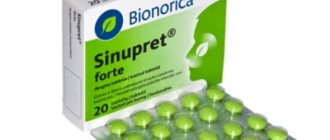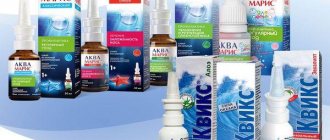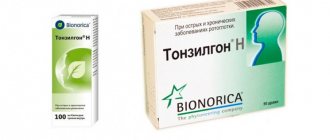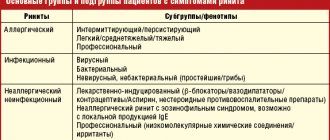How do histamine blockers work? Purpose of application
Histamine is a mediator of inflammatory reactions and a regulator of the physiological functions of the body: it changes vascular tone, bronchial constriction, motility and secretion of the digestive system, and the sleep-wake cycle. Concentrated in “storage areas” - mast cells.
Under pathological conditions, it is released, binds to receptors (there are 4 types) of target organs and causes numerous effects. Participates in any inflammatory reaction. The effect on the target leads to the appearance of symptoms of allergy and inflammation (causes rhinorrhea - discharge of mucus from the nose with rhinitis; lacrimation, redness and swelling of the eyes with conjunctivitis; skin rashes in the form of urticaria).
To relieve symptoms of itching and swelling, a method of blocking the effects of histamine is used. The active molecule of the blocker substance binds to receptors and prevents inflammatory manifestations from occurring.
Cetirizine binds to histamine H1 type receptors. Selectivity for this type (out of 4) ensures a minimum of adverse events.
Two generations
According to the allergo-immunological classification, it belongs to the second generation of antihistamines (two in total). The first includes: Suprastin, Diazolin, Fenistil; second: loratadine (Claritin), desloratadine (Erius), levocetirizine (Xyzal).
Advantages of the second generation compared to the first:
- long-term effect (no need to take 3-4 times a day, 1 time is enough);
- there is no adaptation of the body and the need to replace it with an analogue after 10 days;
- high selectivity (few side effects, no associated effects on other regulatory receptor apparatuses);
- does not penetrate the blood-brain barrier, there is no side sedation (calming effect).
Advantages of Zyrtec
Has all these properties. Additionally, compared to the rest of the group:
- High degree of security. There is no effect on other drugs due to extrahepatic metabolism. Does not modify their effects (distortion occurs when drugs are used together).
- Fast action. From reception to the beginning of the response 20 minutes; for loratadine analogues (Claritin) 30 minutes, for fexofenadine (Telfast) - 60.
Instructions for use
Drops for oral administration and tablets are available.
Used in children from the age of 6 months. Hypoallergenic (no provoking excipients: dyes, flavoring components).
Country of origin: Italy.
How to accept a child. Multiplicity per day:
Age 6-12 months - 5 drops. × 1 time.
From one year to 6 years - 5 drops. × 2 times.
From 6 to 12 years - 10 drops. × 2 times.
Over 12 years old - 20 caps. × 1 time.
Prescribed from 6 years of age, for adults. Ages under 6 years require the use of drops.
In 1 tab. 10 mg of active substance.
- Children: 1/2 tab. 2 times × day (from 6 to 12 years).
- Adults: 1 tab. 1 time × day (over 12 years). You can start taking it with ½ tablet; in some cases, such a dosage of 5 mg is sufficient.
- allergic dermatoses, including urticaria; atopic dermatitis;
- allergic conjunctivitis;
- allergic rhinitis (seasonal, year-round).
- hay fever.
How to buy
Side effect
- Potentially - depression of the nervous system (use with caution when driving and other activities that require concentration); Do not combine with alcohol, as the inhibitory effect may increase. Possible: drowsiness, headache.
- Psychiatric reactions: depression, hallucinations with a frequency of less than 1 case per 100 applications.
- Violation of accommodation. This visual impairment is likely to occur in less than 1 in 10,000.
- Digestive system: dry mouth, dyspepsia; diarrhea.
- Allergic manifestations (skin, angioedema).
- Rhinitis, pharyngitis.
- Tachycardia.
Contraindications
- pregnancy, lactation;
- increased sensitivity;
- age up to 6 months.
- severe renal dysfunction with creatinine clearance less than 10 ml/minute.
The tablets additionally have lactose in their composition: lactase deficiency, glucose-galactose malabsorption.
Peculiarity
Impaired renal function (chronic failure) requires dose adjustment due to excretion through the kidneys.
Zodak instructions for use
The drug is prescribed orally, regardless of food intake. Zodak is available in two dosage forms - tablets and drops. The choice of which form to take the drug depends on the age of the patient. Children from 6 months to 2 years of age are not prescribed tablets; for them, the preferred form is drops, which must be dissolved in water before taking. Adults are prescribed both tablets and drops for allergies. Film-coated tablets should be swallowed whole with a small amount of water.
Adults and children over 12 years of age: 1 tablet or 20 drops (10 mg cetirizine). Children from 6 to 12 years old: 1 tablet or 20 drops (10 mg of cetirizine) once a day or 10 drops (5 mg of cetirizine) 2 times a day, morning and evening.
Children from 2 to 6 years: 1/2 tablet or 10 drops (5 mg of cetirizine) 1 time per day or 5 drops (2.5 mg of cetirizine) 2 times per day, morning and evening.
Children from 1 to 2 years: 5 drops (2.5 mg of cetirizine) 2 times a day.
If the patient has a history of renal failure, then the dose is reduced depending on creatinine clearance (CC): with creatinine clearance 30-49 ml/min – 5 mg once a day; at 10-29 ml/min – 5 mg every other day.
If you miss a tablet or drops, the next dose should be taken as soon as possible. If the time for the next dose is approaching, the dose should be taken as scheduled, without increasing the total amount of the drug taken.
Zodak - instructions for use in video format
Pregnancy and lactation
Figure 3 - The drug is prohibited during pregnancy and lactation
Zodak is forbidden to be taken by women who are preparing to become a mother, as well as throughout the entire period of lactation, since the main active ingredient enters the child’s body with milk. And this can negatively affect the development of the baby’s psyche.
Zodak for children
Figure 4 - Before giving Zodak to a child, you must consult a doctor
The use of Zodak for children is limited only by the age of young patients and the dosage form of the drug itself. It is important to remember that you cannot prescribe anything for yourself or your child. It is necessary to consult with a pediatrician, follow the regimen and dosage indicated by him and described in the instructions. In children, Zodak effectively copes with severe allergy symptoms. As for the dosage form, tablets can be used for children over 6 years of age, drops are used for babies from 6 months under the strict supervision of a doctor.
Interaction of Zodak with other medications
Figure 5 - Combining zodak with alcohol is not recommended
Since Zodak is a medicinal product, its combination with other medications should be regulated by a doctor and the instructions for use. Therefore, you need to talk with your doctor about possible combinations. So, if the patient takes medications containing theophylline (bronchodilators), then the frequency of side effects may increase. The simultaneous use of Zodak and drugs that affect and depress the central nervous system is not recommended. The same applies to alcohol. It is better not to drink alcohol during treatment with Zodak.
Use for psoriasis
Histamine is involved in the manifestation of the symptoms of chronic inflammation (including psoriatic).
Since in psoriatic disease, skin manifestations in the form of scaly spots are accompanied by itching (periods of exacerbation), a decrease in the hyperactivity of the histamine system is justified. To relieve itching, antihistamines are included in the therapeutic regimen.
Regimen for the treatment of psoriatic disease are not limited to 1-2 medications, since not only the skin is affected. There are concomitant pathologies of other organs (often: joints; digestive organs). Multicomponent therapy involves the risk of mutual influence of drugs.
The main route of metabolic transformations is through the liver. The advantage of cetirizine is its extrahepatic processing: it does not interfere with the metabolism of other drugs.
Zyrtec is an original medicine with an evidence base for effectiveness and safety. There are up to 20 variants of reproduced copies on the Russian market (Tsetrin, Parlazin). Each analogue differs in the degree of therapeutic equivalence to the reference drug (original).
To compare generics and the original, bioequivalence is compared. It differs because different auxiliary components, production conditions, and the quality of purification of the ingredients are used to obtain the dosage form.
Any change affects the effectiveness and safety of treatment: additional adverse reactions occur; bioavailability changes. The same active substance should not mislead about the equivalence and equal safety of treatment.
Only the presence of a reliable evidence base for a generic product to match its characteristics makes it a full-fledged substitute.
The competitive advantage of copies is the low cost of daily treatment.
Copy or original? Zodak
Zodak is a copy made by Zentiva, Czech Republic. The price of one tablet is half as much. Not bad reviews. Similar forms of release; additionally available in syrup. The indications according to the instructions are the same.
European manufacturing and the presence of our own evidence base are advantages. But in a comparative study, Zyrtec was found to be more effective than Zodak. Among the reproduced copies, the therapeutic equivalence of the Indian Cetrin and Parlazin (Hungary) is comparable to the original. These analogues are used as an economical replacement for Zyrtec. The price of any of these generics in terms of a daily dose is lower.
Zyrtec does not have a children's dosage form "syrup", this is justified. Drops have advantages compared to syrup: they do not include taste or color correctors, so the likelihood of allergies is lower. But for cases when the buyer prefers syrup for the child, the options are:
- Zodak (Czech Republic);
- Zintset (India);
- Tsetrin (India).
The indications and active substance according to the medical instructions are similar.
Zyrtec - instructions for use
INSTRUCTIONS (information for specialists) on the medical use of the drug
Registration number : Film-coated tablets: P No. 014186/01; Drops for oral administration: P No. 011930/01
Trade name : Zyrtec ®
International nonproprietary name : Cetirizine
Chemical name: 2-(2-(4-(p-chloro-alpha-phenylbenzyl)-1-piperazin-yl)ethoxy)-acetic acid (as dihydrochloride)
Dosage form : Film-coated tablets; Drops for oral administration
Compound
Tablets: active substance - cetirizine dihydrochloride 10 mg. Excipients: microcrystalline cellulose, lactose, colloidal silicon dioxide, magnesium stearate, hypromellose, titanium dioxide, macrogol (polyethylene glycol)-400.
Drops for oral administration: active substance: cetirizine dihydrochloride 10 mg/ml. Excipients: glycerol, propylene glycol, sodium saccharinate, methylparabenzene, propylparabenzene, sodium acetate, glacial acetic acid, purified water.
White oblong film-coated tablets. Each tablet is scored and marked on one side Y/Y.
Drops for oral administration: Clear, colorless liquid with the odor of acetic acid.
Pharmacotherapeutic group : antiallergic agent (H1-histamine receptor blocker).
ATX code : R06AE07
A competitive histamine antagonist, a metabolite of hydroxyzine, blocks H1 histamine receptors. Prevents the development and facilitates the course of allergic reactions, has antipruritic and antiexudative effects. Affects the “early” histamine-dependent stage of allergic reactions, limits the release of inflammatory mediators at the “late” stage of the allergic reaction, reduces the migration of eosinophils, neutrophils and basophils, stabilizes mast cell membranes. Reduces capillary permeability, prevents the development of tissue edema, and reduces spasm of smooth muscles. Eliminates skin reactions to the introduction of histamine, specific allergens, as well as to cooling (with Cold urticaria). Reduces histamine-induced bronchoconstriction in mild bronchial asthma. It has virtually no anticholinergic and antiserotonin effects. In therapeutic doses it has virtually no sedative effect. The onset of effect after a single dose of 10 mg of cetirizine is 20 minutes (in 50% of patients) and after 60 minutes (in 95% of patients), lasting more than 24 hours. During a course of treatment, tolerance to the antihistamine effect of cetirizine does not develop. After stopping treatment, the effect lasts up to 3 days.
Pharmacokinetics . Rapidly absorbed when taken orally. Maximum serum concentrations are achieved 1 hour after oral administration. Food does not affect the completeness of absorption, but prolongs the absorption process by 1 hour. 93% of cetirizine is protein bound. The pharmacokinetic parameters of cetirizine have a linear relationship. Volume of distribution - 0.5 l/kg. In small quantities, it is metabolized in the liver by O-desalcation to form a pharmacologically inactive metabolite (unlike other H1-histamine receptor blockers, which are metabolized in the liver with the participation of the cytochrome P450 system). Does not cumulate. 2/3 of the drug is excreted unchanged by the kidneys and about 10% in the feces. Systemic clearance - 53 ml/min. The half-life is 7-10 hours, in children 6-12 years old - 6 hours, in children 2-6 years old - 5 hours, 6 months to 2 years old - 3.1 hours. In elderly patients, the half-life increases by 50%, systemic clearance by 40%. Practically not removed by hemodialysis. Passes into breast milk.
For adults and children 6 months and older: treatment of symptoms of year-round and seasonal allergic rhinitis and allergic conjunctivitis, such as itching, sneezing, rhinorrhea, lacrimation, conjunctival hyperemia; hay fever (hay fever); urticaria, including chronic idiopathic urticaria, Quincke's edema; and other allergic dermatoses, including atopic dermatitis, accompanied by itching and rashes.
Contraindications
Hypersensitivity to any of the components of the drug or to hydroxyzine. Pregnancy, lactation period. Children's age up to 6 months.
Carefully
Chronic renal failure (moderate and severe), old age (possibly decreased glomerular filtration).
Directions for use and doses
Adults and children over 6 years of age: daily dose - 10 mg (1 tablet or 20 drops). Adults - 10 mg once a day; children: 5 mg 2 times a day or 10 mg once. Sometimes an initial dose of 5 mg may be sufficient to achieve a therapeutic effect.
For patients with renal failure, the dose is reduced depending on creatinine clearance: with creatinine clearance 30-49 ml/min - 5 mg 1 time per day; at 10-29 ml/min - 5 mg every other day.
Side effect
Drowsiness, headache, dry mouth; rarely - headache, dizziness, migraine, diarrhea, allergic reactions: angioedema, itching, rash, urticaria.
Overdose
When taking the drug once in a dose of more than 50 mg, the following symptoms may be observed: drowsiness, anxiety and increased irritability, urinary retention, dry mouth, constipation, mydriasis, tachycardia. If symptoms of overdose appear, you should stop taking the drug, rinse your stomach, take activated charcoal, and consult a doctor immediately.
Interaction with other drugs
No pharmacokinetic interaction or clinical effect was observed when co-administered with pseudoephedrine, cimetidine, ketoconazole, erythromycin, azithromycin, diazepam, glipizide. When co-administered with theophylline at a dose of 400 mg 1 time per day, a decrease in creatinine clearance by 16% was noted. When co-administered with macrolides and ketoconazole, no changes were noted on the ECG.
When used in therapeutic doses, no data on interaction with alcohol have been obtained (at a blood alcohol concentration of 0.5 g/l). However, it is best to avoid drinking alcohol during treatment with cetirizine.
An objective quantitative assessment of the ability to drive a car and operate machinery did not reliably reveal any adverse events when prescribing the recommended dose of 10 mg, however, caution is recommended.
Release form
Film-coated tablets in blisters of 7 or 10 tablets are packed in one blister along with instructions for use in a cardboard box.
Drops for oral administration: 10 ml or 20 ml of solution in dark glass bottles (type 3), sealed with a polyethylene cap equipped with a child safety system. The bottle is equipped with a dropper cap made of white low-density polyethylene. The bottle along with instructions for use is placed in a cardboard box.
Storage conditions
Zirtec drops - instructions for use
The drug has an antiallergic effect, helping to eliminate most symptoms. Before using the product, you should carefully study the instructions with information about indications, contraindications and method of use. Important information includes side effects. In therapeutic doses, the antiallergic drug does not have a sedative effect and does not cause drowsiness. At the same time, the components of the product impair digestion or contribute to the appearance of skin reactions.
Release form and composition of the drug
Zyrtec is available in the form of drops for oral administration. The drug is a clear, colorless solution and has a faint odor of acetic acid with a bitter taste. The drops are placed in a dark glass bottle with a capacity of 10 ml. In addition to it, the cardboard box contains a dropper cap and instructions for use. The components of Zyrtec per 1 ml of product are shown in the table.
| Name | Content, mg |
| Active substances: | |
| cetirizine hydrochloride | 10 |
| Excipients: | |
| glycerol | 250 |
| propylene glycol | 350 |
| sodium saccharinate | 10 |
| methylparabenzene | 1.35 |
| propylparabenzene | 0.15 |
| sodium acetate | 10 |
| glacial acetic acid | 0.53 |
| distilled water | up to 1 ml |
Pharmacodynamics and pharmacokinetics
The antiallergic drug Zyrtec belongs to the group of selective antagonists of peripheral histamine receptors. After a course of cetirizine, no effect on brain H1 receptors was detected. The product helps eliminate the symptoms of allergic diseases, thanks to its antipruritic and antiexudative effect. At the same time, the drug has almost no anticholinergic, antiserotonin effect.
The effect of taking the drug is observed after 20 minutes of a single dose of 10 mg or 20 drops. The maximum concentration of cetirizine is reached after 60 minutes, after which the effect of the drug is observed for 24 hours. Zyrtec is quickly and completely absorbed from the gastrointestinal tract (gastrointestinal tract). Concomitant food intake does not affect the absorption of the active substance.
Indications for use
Zyrtec has an antiallergic effect, so doctors prescribe the drug to treat allergy symptoms such as itchy skin, watery eyes, and sneezing. Direct indications for taking the medicine are also: rhinorrhea, conjunctival hyperemia, swelling, irritation and skin rashes. This antihistamine is prescribed for the following diseases:
- Quincke's edema;
- hay fever (hay fever);
- seasonal allergies – allergic rhinitis, allergic conjunctivitis;
- hives;
- bronchial asthma;
- allergic dermatitis.
Zyrtec for children
Not only adults, but also children can suffer from psoriasis. Their disease manifests itself as:
- Rash on the cheeks and body;
- Peeling of the skin;
- Redness of the skin;
- Diaper rash, itching, etc.
In children, psoriasis can appear as a result of genetic predisposition, weakened immune defense, stress (transition period - kindergarten, school), etc.
The medicine Zyrtec in the form of drops was developed especially for young patients. The product is intended to treat problems such as:
- Year-round allergic rhinitis;
- Seasonal allergic rhinitis;
- Allergic conjunctivitis;
- Chronic idiopathic urticaria;
- Manifestation of symptoms of psoriasis.
Dosage of drops, method of application
For clarity, below is a table from which you can find out in what dosage to give the drug Zyrtec in the form of drops:
Features of application
It is prohibited to give drops undiluted. You need to drop them into a tablespoon and then dissolve them in water. The ratio of drops and water should be 1:1. The medicinal solution must be taken freshly; preparing it in advance is prohibited.
Taking Zyrtec drops for children aged six months to one year must be agreed with a doctor.
Nasal drops for children Zirtec: instructions for use, contraindications and reviews.
A child’s illness is always a cause for concern for any good parent. Zyrtec is considered a fairly popular medical drug. Available in the form of drops for oral use. The main active ingredient is cetirizine hydrochloride .
In addition, the composition contains the following substances: sodium acetate, glycerin, sodium saccharinate, water, methyl parahydroxybenzoate, acetic acid and propylene glycol. This type of drug is prescribed to children in the following cases:
- with permanent or seasonal allergic conjunctivitis, as well as allergic rhinitis, which manifests itself in the form of itching, constant leakage of fluid (secreted by the mucous membrane) from the nasal cavity, sneezing, involuntary release of tears, redness of the eyes;
- for allergies to dust and pets;
- with its help, it is possible to effectively get rid of inflammatory processes that occur during colds , sinusitis, sore throat and various viral diseases;
- after insect bites, if the child has even the slightest signs of allergies;
- in the case where there is a food allergy;
- as a result of hay fever;
- in the presence of urticaria or Quincke's edema;
- Zyrtec is prescribed as an additional drug in the treatment of spasmodic bronchitis and bronchial asthma;
- if a child has dermatitis , which must necessarily be accompanied by itching and various types of rashes.
The drug under analysis is prescribed to children over 12 months of age. In this case, up to six years of age, Zyrtec is used in a dosage of up to 5 drops no more than twice within 24 hours.
Children over six years old are allowed to take this type of drug orally in a volume of up to 20 drops. In this case, this dose should be divided into two doses and taken in one day.
When diagnosing allergic rhinitis, Zyrtec is used as nasal drops. Before dripping it into the nose, the nasal passages are thoroughly cleaned of mucus accumulated in them. For effective action of the medicine, use a pipette. Place one drop into each nostril. Treatment in this way is continued until all allergy symptoms disappear.
Indications for use of Encephabol syrup for children: prices and reviews.
The effectiveness of the drug Cytovir 3 for children: instructions for use.
- too sensitive to cetirizine or other components of the drug;
- end-stage renal failure;
- Due to the fact that to date there has not been a sufficient number of studies on Zyrtec regarding its effect on the child’s body up to 6 months of age, it is not recommended to prescribe it to babies at this age.
In addition, children with chronic renal failure and epilepsy should use the drug under analysis with caution After passing additional tests, the drug can be prescribed to children suffering from sudden onset of seizures, as well as people with problems with urination.
Due to the fact that Zyrtec has a depressant effect on the nervous system, this drug is prescribed to children under 12 months of age after additional consultation, since it can cause infant death in their sleep. With caution, Zyrtec is also prescribed to such young children in the following cases: sudden death of a brother or sister; someone in the family already has apnea syndrome; smoking by a mother who is breastfeeding or taking drugs.
In rare cases, this drug is prescribed to premature babies, as well as to those who were born with low birth weight.
This medicine should not be taken with other drugs that depress the nervous system.
In some cases, after taking Zyrtec, the following side effects may be observed: dry mouth, difficult digestion, drowsiness, headache, excitability (in some patients), swelling of the mucous membranes.
Very rarely, anaphylactic shock, fainting, tic, amnesia, diarrhea, increased appetite, tachycardia occur.
overdose can contribute to the occurrence of all of the above side effects . In this case, immediately perform gastric lavage and drink activated charcoal.
are stored at temperatures from 15 o C to 20 o C. The service life is 5 years.
The most popular analogue is Zodak. In addition, in pharmacies you can buy Letizen, Parlazin, Cetirizine, Allertek, etc. as an analogue to Zyrtec.
Available in 10 ml bottles. The price depends on the manufacturer. So, drops in a 10 ml container can cost from 325 rubles. up to 348 rub.
“An excellent product, it helps my child with dermatitis”
Olga O.
According to Katerina
Zyrtec tablets for adults and children
The drug Zyrtec in tablet form should be taken by adults, 1 pill 1 time per day. If we are talking about elderly patients, then they should also adhere to this dosage. They do not need to reduce the dosage.
If the patient suffers from renal failure, then the dosage regimen of Zyrtec tablets must be adjusted with the attending physician. The fact is that the medicine is excreted by the kidneys, so in order not to burden them, the doctor will have to adjust the regimen for taking the antihistamine.
Patients with impaired liver function do not need to adjust the dosage regimen of Zyrtec tablets.
Zirtec tablets and tablets
form are cheaper than in the form of drops. Therefore, many parents are interested in the question: “Can this drug be given to children?” Yes, you can, but only from 6 years old. The dosage of tablets in this case should be as follows:
- Children 6–12 years old should be given ½ pill 2 times a day;
- Children over 12 years old – 1 tablet once a day.
Zyrtec for allergies for children: dosage, drug analogues and estimated cost
Doctors emphasize that a child under 6 years of age should be given the medicine only in the form of a solution, since even a small tablet is quite easy to choke on.
Zyrtec allergy drops for children are used as follows:
- From 6 months to 1 year - 5 drops (which corresponds to 2.5 mg of cetirizine) per day for 1 dose;
- At the age of 1-2 years - 5 drops twice a day;
- From 2 to 6 years - the dosage remains the same, that is, 5 drops 2 times a day, but it is allowed to take the drug for prophylactic purposes, 5 drops of the medicine 1 time a day.
The cost of Zyrtec for children and adults is 355-400 rubles per 10 ml bottle. The price of tablets varies depending on the number of pills in the package, from 220 rubles for 7 pieces and 430 for 20 pieces. Allergy drops for children Zyrtec are not the only antihistamine based on cetirizine.
You can buy other medications with the same composition at the pharmacy:
- Zodak (drops, tablets and syrup);
- Parlazin (drops and tablets);
- Cetirizine Hexal (tablets, drops);
- Cetirinax (tablets);
- Cetrin (drops, tablets and syrup).
Reviews from patients indicate the high effectiveness of the drug Zyrtec, the child’s general well-being quickly changes for the better, and all symptoms of the disease disappear. Experts say that cetirizine and drugs based on it are completely safe for use at any age, subject to strict adherence to the dosage regimen.
Benefits of Zyrtec
Zyrtec drops and tablets are recommended by many allergists because:
- The drug is suitable for children from 6 months;
- The manufacturer has developed a product for the whole family: in the form of drops and tablets;
- The drug in both forms of release does not contain sugar or dyes;
- Provides quick results - allergy symptoms disappear within a few minutes after taking the medicine;
- Has a prolonged result – helps a person forget about the symptoms of psoriasis for the whole day;
- It has a low cost (the cost of a tablet for one day of use is only 20 rubles);
- The drug is a widely available drug - Zyrtec is sold in almost all pharmacies in the country;
- The drug Zyrtec is the leader among antihistamines prescribed by allergists and pediatricians (data for 2017). The study was conducted independently in major cities of Russia.
Instructions for use of antihistamines
Any medicine must be prescribed by a doctor, and its use and the reaction of the child’s body must be monitored. Zyrtec drops can be given to a child on their own only as a last resort. Immediately after this, you must contact a specialist to prescribe further treatment. Under any circumstances, you must strictly follow the permissible dosage of the drug.
Children aged 6 months to 2 years can take 5 drops at a time. From 2 to 6 years old, 10 drops are given. At an older age, the dosage can be increased to 20 drops.
Doctors often prescribe this drug to younger children, significantly reducing the dosage and constantly monitoring the body’s reaction. In this case, you should never give drops yourself.
How long you can take Zyrtec drops for children is determined by a specialist based on the manifestation of an allergic reaction. The instructions for use of the drug highlight the various methods and duration of use of the drops. This depends on the manifestation of the allergic reaction; it can be year-round, seasonal or one-time (with the strict exclusion of the allergen, if possible).
Zyrtec or Zodac?
The active ingredient in both products is the same - cetirizine hydrochloride. The auxiliary components are somewhat different, but one and the second preparation do not contain sugar or dyes. You can determine which drug is better from the following conclusions:
- Zyrtec is the original drug, and Zodac is a generic drug. Zyrtec has been subjected to more rigorous medical research and more testing. And the effect of its identical development has been practically not studied.
- Zyrtec is more expensive. So, for 30 Zodak tablets you need to pay about 250 rubles, and for just 20 Zyrtec tablets you need to pay as much as 400 rubles.
- Zodak is prescribed only from 1 year of age, while Zyrtec can be taken by children from six months (according to the doctor’s testimony).
It is impossible to say which of the two drugs is better. Each has its own pros and cons. I would only like to note the fact that often allergists or pediatricians give patients the right to choose. Both drugs are well tolerated by patients, are not addictive, and both drugs have side effects.
The price of the antihistamine Zyrtec depends on the form of the drug, the volume of the bottle or the number of tablets in the package:
- Zyrtec drops, bottle volume 10 ml, price 300 – 350 rubles;
- Zyrtec in tablets, 7 pills per package at a price of 200 - 230 rubles;
- Zyrtec tablets, 20 pills per package, priced at 400 – 420 rubles.
Speaking about the drug in tablet form, it is more profitable to buy Zyrtec in larger quantities. Then the cost of one tablet will be approximately 20 rubles, and if you buy Zyrtec in a package of 7 pills, then the cost of one tablet will be 30 rubles. The difference is 10 rubles per pill.
Zirtec, analogues of the drug in drops and tablets
If the pharmacy does not have the drug Zyrtec, analogues, which are also anti-allergy drugs, are always on display.
It is not advisable to select a medicine on your own; it is important to listen to the recommendations of a doctor who will recommend a medication that is individually suitable for its effect and the absence of undesirable consequences.
Often, a patient’s choice is faced with the question of what is better: Zyrtec or other 2nd generation antiallergic analogues.
What is Zyrtec?
Zyrtec is an antihistamine medicine that is sold in drops and tablets. Cetirizine hydrochloride, a pharmaceutical substance, helps get rid of common allergic symptoms of various etiologies:
- irritation of skin receptors;
- seasonal rhinitis;
- angioedema;
- painful muscle tension;
- tearfulness;
- drug, food allergic reaction.
Zyrtec is often prescribed by pediatricians to help treat otitis media and adenoiditis. The drug helps relieve nasal and ear congestion.
Antihistamine medicine does not treat ENT diseases, but has a complex effect on the child’s recovery.
Zyrtec drops
After taking the medicine, a person feels healthy within 20-60 minutes. Zyrtec works for 24 hours, then, if allergic symptoms appear again, it is recommended to take the drug again.
Zyrtec does not have a sedative effect; while taking an antihistamine, it is not prohibited to drive a car or engage in mental or physical labor that requires concentrated attention.
The effectiveness of Zyrtec is noticeable when:
- nettle rash;
- allergic inflammation of the mucous membrane of the eyes;
- hay fever - seasonal allergic reactions;
- atopic dermatitis syndrome.
Naturally, Zyrtec is not the only drug of its kind that fights allergies - pharmacies will easily offer analogues of Zyrtec. Therefore, a person intending to buy a drug with the required effect can find a drug at a suitable price.
Zyrtec drops for children: instructions for use, reviews, dosage, analogues and prices
Antihistamine in children's form. Shows antiallergic and antiexudative effects. Prescribed for allergic etiology of the disease, as well as as an adjunct to eliminate swelling and nasal congestion. No addiction to the active substance is observed. The drug can be prescribed from 6 months of age.
Now let's look at this in more detail.
For children, Zyrtec is available in drops for oral administration.
The drops are a colorless, transparent liquid that smells like acetic acid.
1 ml of dosage form contains 10 mg of active substance.
The following are added as additional components:
- glycerol;
- macrogol;
- saccharin;
- methylparabenzene;
- propylparabenzene;
- E 262;
- anhydrous ethanoic acid;
- water.
The drug is available in dark glass dropper bottles, the volume of which can be 10 or 20 ml.
The active substance is a competitive antagonist of histamine, a mediator of an immediate allergic reaction. It prevents the occurrence and facilitates the course of allergies, and has an anti-exudative effect. They influence the early (histamine-dependent) and late (cellular) stages of the allergic reaction. Stabilizes the mast cell membrane, reduces the movement of neutrophilic, basophilic and eosinophilic granulocytes.
Reduces capillary permeability, relieves spasm of smooth muscles, prevents tissue swelling.
Cetirizine reduces the likelihood of occurrence and relieves allergy symptoms such as:
- skin rash and itching;
- swelling;
- symptoms of rhinitis and conjunctivitis: redness of the white of the eye, lacrimation, swelling of the eyelids, nasal congestion and nasal mucus, sneezing and others;
- inflammation of the skin observed in atopic dermatitis;
- bronchospasm in mild bronchial asthma.
When taking the drug in therapeutic dosages, it does not cause sedation.
During treatment with cetirizine, addiction to its antiallergic effect is not observed. After taking the medication in a dosage of 10 mg, the therapeutic effect in every second patient occurs within 20 minutes, in 95% - within an hour and lasts for 24 hours. After completing the course of therapy, its effect lasts 72 hours.
After oral administration, the drug is well absorbed from the digestive tract. In this case, food intake does not affect the degree of absorption. After a 10-day course of treatment, no accumulation of the active substance is observed.
Passing the liver barrier, a small amount of cetirizine is metabolized to form inactive metabolites.
The medication is excreted primarily unchanged in the urine.
The half-life depends on the patient's age:
General concept of analogues
Analogues are medicines with identical compositions, differing in that one medicine is patented, the manufacturer of which is the parent company, and the rest are called generics.
Analogs and patent-protected medicines have the same composition, do not differ in effectiveness from medicines protected by patent law, but are noticeably inferior in price.
Manufacturers of high-quality analogues research and compare the effectiveness and safety of a patented medicine and its substitute.
Many people incorrectly believe that analogues are medications with the same effect. There are many remedies for allergies, but they cannot be called analogues of each other due to the difference in composition and the different effects they have on the patient.
Types of analogues
Zyrtec analogues are classified into:
- Absolute analogues are drugs with the same composition;
- Relative analogues are drug substitutes that differ in composition, but have a similar effect on the human body.
Absolute antihistamines similar to Zyrtec:
- Alerza;
- Zodak;
- Allertek;
- Letizen;
- Cetrin;
- Xizal;
- Cetirizine;
- Telfast;
- Parlazin;
- Cetirinax and many other allergy medications.
It should be noted that the above medications are much cheaper than Zyrtec.
The medicines Cetirinax and Parlazine also contain the active substance - cetirizine hydrochloride. These generics are equally effective, but they are not recommended for children.
Relative analogues of Zyrtec:
The pharmaceutical substances in these medications differ from the composition of Zyrtec, but they have identical effects on the body.
All of the above analogues have the same indications for use, but before you start taking the Zyrtec analogue, you should definitely consult with an allergist.
Zodak is considered a complete Russian analogue of Zyrtec in all respects: it has a similar therapeutic effect, has the same pharmacokinetic parameters, just like Zyrtec, you can buy drops or tablets.
Zyrtec and Zodak are interchangeable for all patients - the generic can be given even to children.
Zodak
An alternative to Zyrtec may be the drug Fenistil, the active substance of which is called Dimetindene. The generic has more undesirable consequences and is less effective.
Manufactured types of Fenistil: tablets intended for use by children over 6 years of age and adults, as well as drops for children from 6 months to preschool age.
Similar to Zyrtek, Fenistil is not recommended for use in children from birth to 6 months, pregnant and lactating women, but sometimes pediatricians prescribe the drug to newborns according to individual indications under strict medical supervision.
Fenistil
Analogues based on Loratadine
There are antihistamines with the main substance called Loratadine. Generics also belong to the 2nd generation of antiallergic drugs.
Loratadine is as effective as Zyrtec. Unlike a person's individual reaction, sometimes Loratadine works better than Zyrtec.
In addition to Loratadine, there are substitutes Claritin, Erolin, but they have a sedative effect, while Loratadine does not cause fatigue and drowsiness, and does not depress the central nervous system.
Preparations based on Loratadine are not prescribed to infants under 6 months, pregnant women and nursing mothers.
It is worth giving preference to the drug Erius, which belongs to the 3rd generation and is based on Desloratadine. Erius is an improved type of Loratadine without sedative symptoms and undesirable effects.
The drug is produced in tablets and syrup, it is highly effective - it stops allergic attacks within the first minutes after administration.
It is not known how safe and effective Erius is for children under 6 months of age and pregnant women, but it has been found that Desloratadine passes into breast milk, so the drug is contraindicated for nursing mothers.
Erius for allergies
Suprastin and Tavegil
Antiallergic drugs belong to the 1st generation, are considered imperfect and are rarely used. Suprastin differs from Tavegil in the active substance: the active ingredient of Tavegil is Clemastine, the active ingredient of Suprastin is Chloropyramine.
Tavegil and Suprastin have quite a few contraindications and side effects, while having low effectiveness. Therefore, if possible, it is better to avoid the use of 1st generation antihistamines, replacing them with more advanced generics of Zyrtec.
Suprastin and Tavegil
Cetrin and analogues with cetirizine
The active ingredient of the generic is cetirizine, which provides relief and relief from allergic symptoms within an hour.
After completion of the course of treatment, the therapeutic effect lasts 3-4 days.
Allergy sufferers often think about: Zyrtec or Cetrin. The composition of both drugs is identical, but the analogue is cheaper than the patented product.
The substance Cetirizine successfully fights not only allergic symptoms, but also attacks of bronchial asthma and the elimination of other diseases. Other analogues of Zyrtec with the active substance Cetirizine:
- Cetirizine HEXAL;
- Parlazin;
- Cetirinax;
- Letizen.
Tsetrin
Instructions for use of drops
Zyrtec is prescribed to children in the form of drops when any allergic reactions occur in the body. It reduces the appearance of rashes, body temperature, itching and helps cope with other allergy symptoms.
Indications for use:
- Chronic and seasonal exacerbations of the common cold. Characteristic signs of allergic rhinitis: nasal congestion, continuous sneezing, itching in the nasal cavity.
- Allergic conjunctivitis. It is expressed in inflammation of the outer eyelid and its swelling.
- Allergic urticaria and atopic dermatitis. It appears as a rash over the entire surface of the skin and is accompanied by severe itching. Urticaria is especially dangerous because it can lead to Quincke's edema.
- Bronchial asthma and obstructive bronchitis.
- Contact dermatitis. Appears as a result of an insect bite. The bite site swells and causes severe itching.
- As an anti-inflammatory agent for colds, viral diseases, sore throat, sinusitis, bronchitis.
Since children respond well to treatment with Zyrtec drops, pediatricians can prescribe them to prevent allergies in the warm season.
Age restrictions
When taking Zyrtec, you must carefully follow the exact dosage of the drug. It has its own age restrictions and is:
- children from 1 year to 2 years are prescribed 5 drops diluted with water, 1-2 times a day;
- from 2 to 6 years, 10 drops are prescribed: 5 in the morning and in the evening;
- Children over 6 years of age are prescribed 20 drops per day, either a one-time use of the full dose or dividing it into 2 parts is possible.
The drug is also not prohibited for children from 9 months to 1 year, however, only the doctor decides how many drops of Zyrtec to give to the child in this case. The child's condition is constantly monitored by the parents and pediatrician. If any side effects occur, the drug should be discontinued immediately and consult a doctor.
In the acute form of allergic rhinitis, the drug Zyrtec is prescribed in the form of nasal drops. To do this, before using it, it is necessary to completely clear the nasal sinuses using sea water or saline solution. The duration of taking the drug is prescribed by the doctor depending on the severity of the allergic reaction and the development of complications.
In the absence of contraindications, Zyrtec can be taken once without consulting a doctor.
Contraindications
Taking Zyrtec drops is contraindicated for babies under 9 months, as well as for children with individual intolerance to some components of the drug, which can lead to allergic reactions in the form of a runny nose and rash. It is not recommended to give the drug to children with kidney and liver pathologies. An individual reduced dosage for these diseases can only be prescribed by a qualified specialist.
Possible side effects:
- abdominal pain;
- slight dizziness and headache;
- nausea, loose, unstable stools;
- general weakness of the body: lethargy, fatigue, drowsiness.
In case of accidental overdose, Zyrtec can lead to serious complications in the functioning of the child's body. If this happens, call a doctor immediately and give your child 2-3 tablets of white activated carbon.
Overdose causes symptoms such as:
- increased aggression;
- tachycardia;
- insomnia;
- convulsions;
- dysfunction of the liver and kidneys;
- urinary retention.
If the required doses are observed, any side effects occur extremely rarely and do not manifest themselves fully. However, as soon as you notice any of the above symptoms, you should stop taking the drug and consult your doctor. The doctor will decide whether to continue taking Zyrtec drops or suggest a more suitable analogue.











